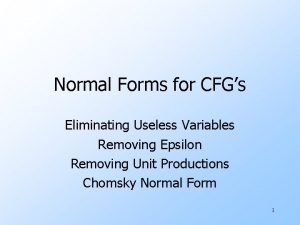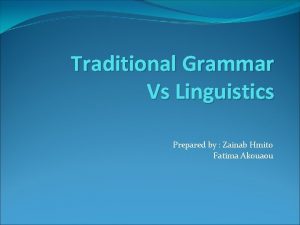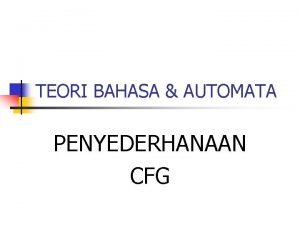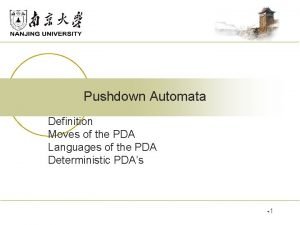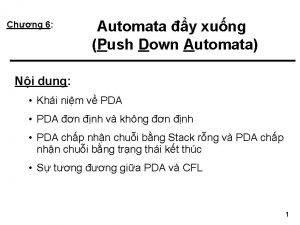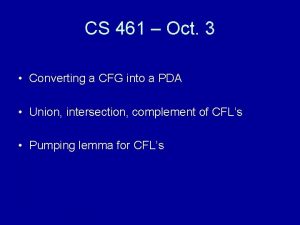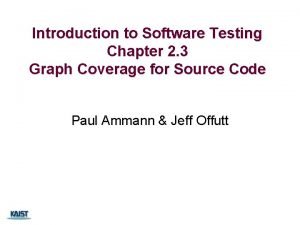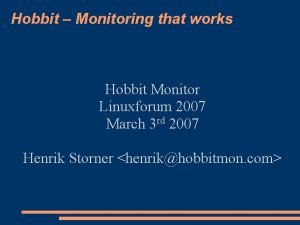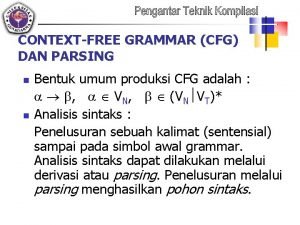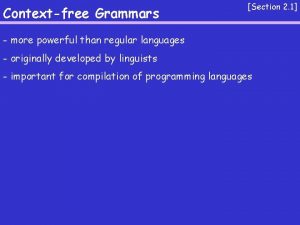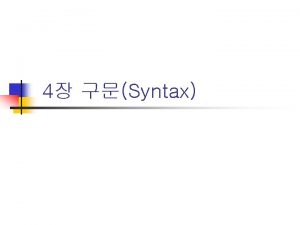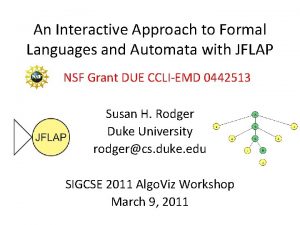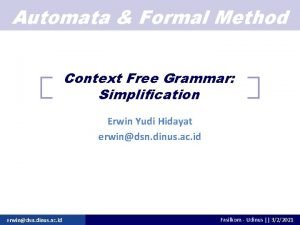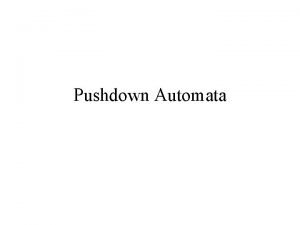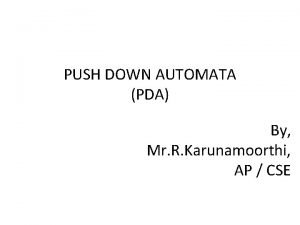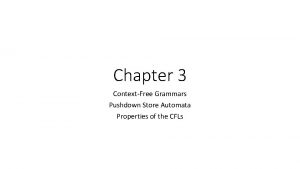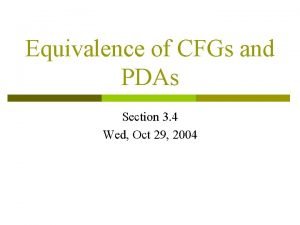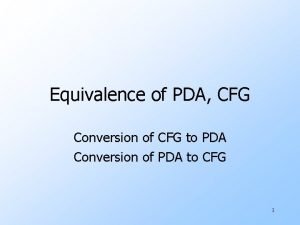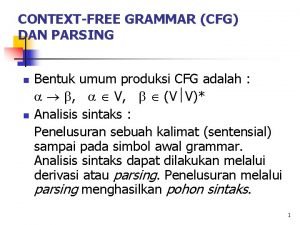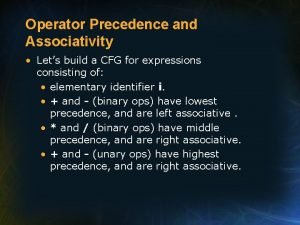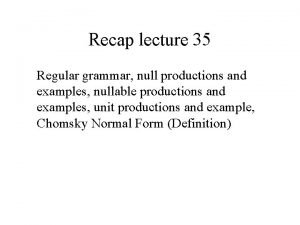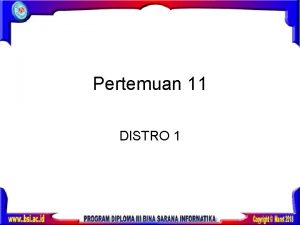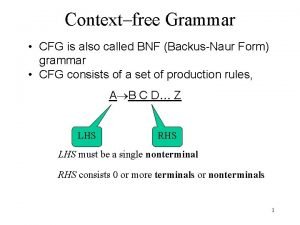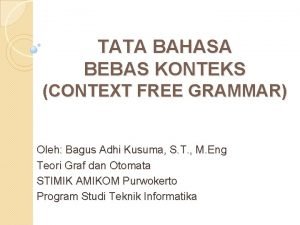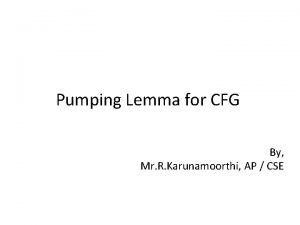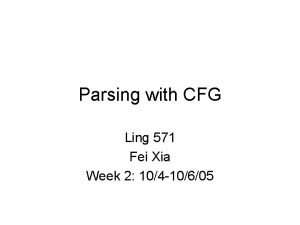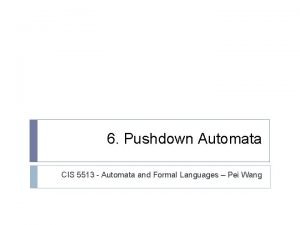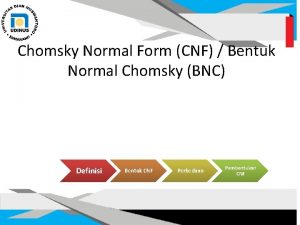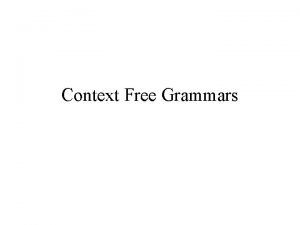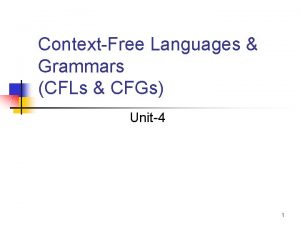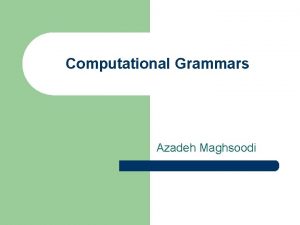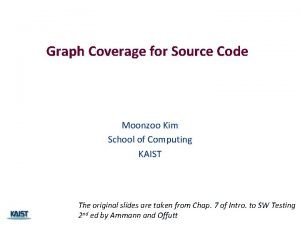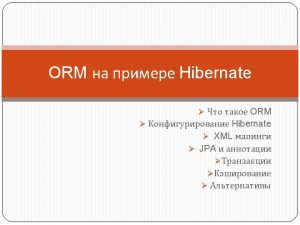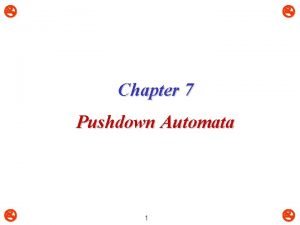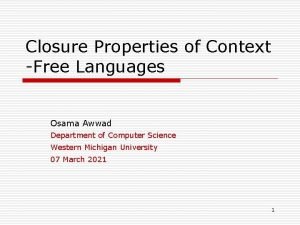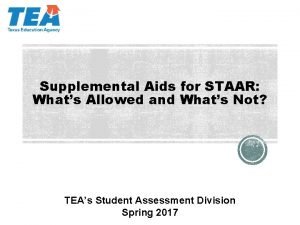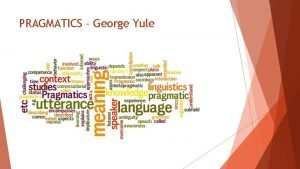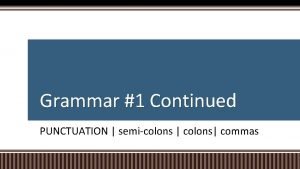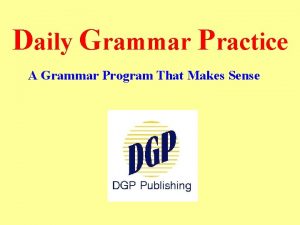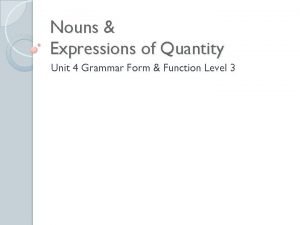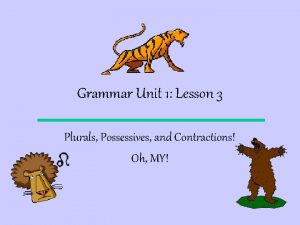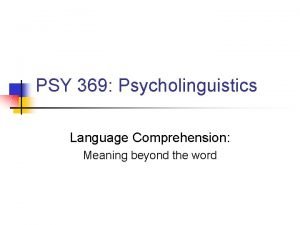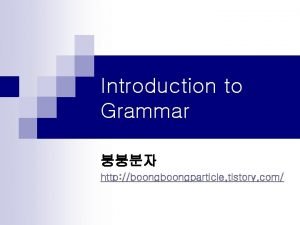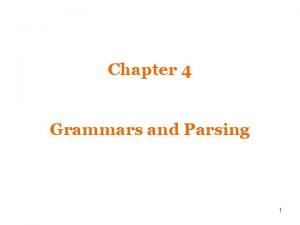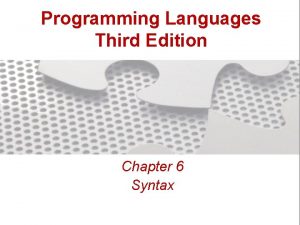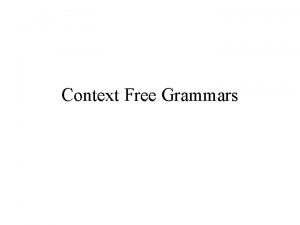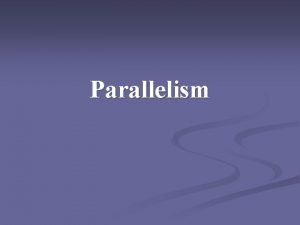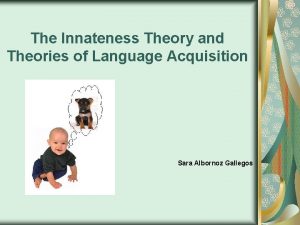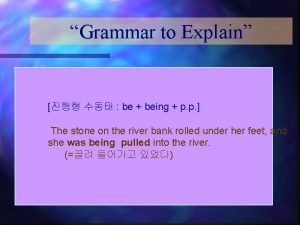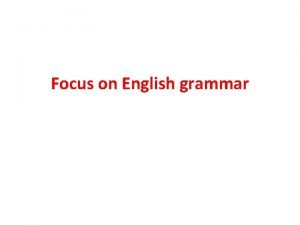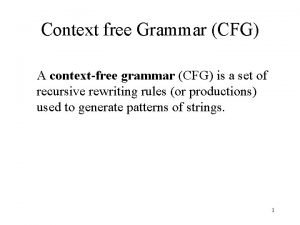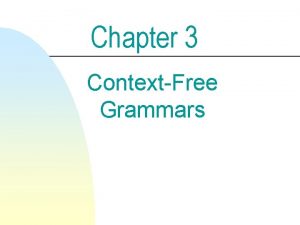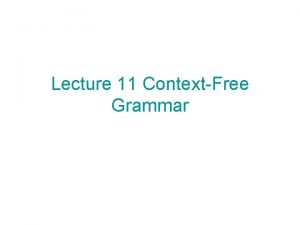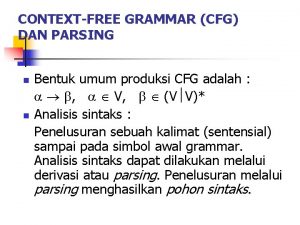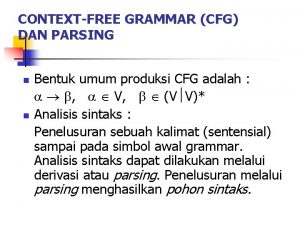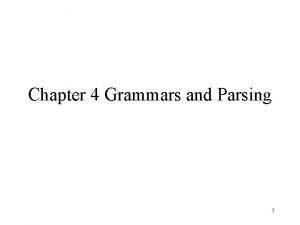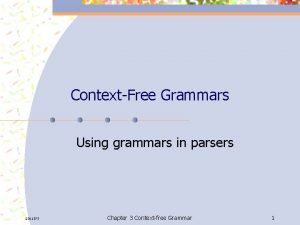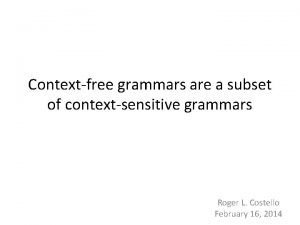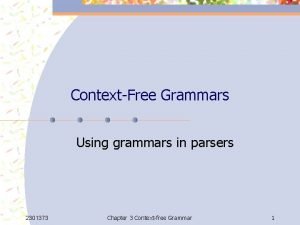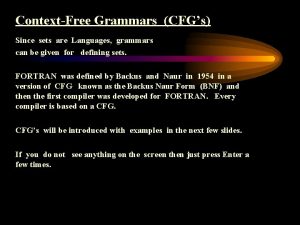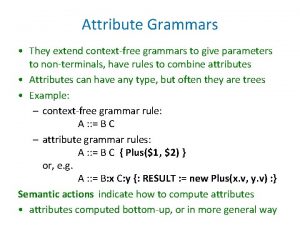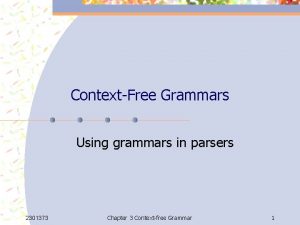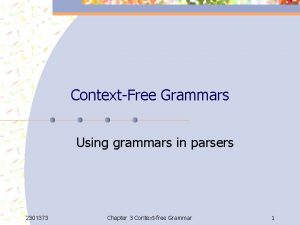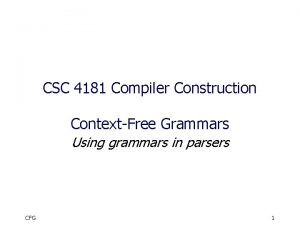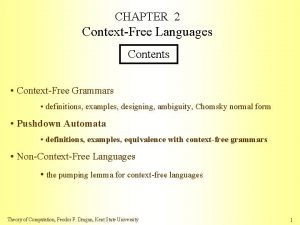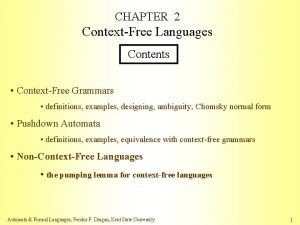CONTEXTFREE GRAMMARS A contextfree grammar CFG is a





































































- Slides: 69


CONTEXT-FREE GRAMMARS วตถประสงค A context-free grammar (CFG) is a simple recursive method of specifying grammar rules by which strings in a language can be generated. To a large extent, they are capable of specifying the syntax of high-level programming languages and other formal languages.

การนยามภาษา CONTEXT-FREE GRAMMARS DESCRIBE THE LANGUAGES Using recursive definition to describe any languages (regular or nonregular). Example, palindrome language. Alphabet = { a, b} Rule 1: , a, b PALINDROME Rule 2: For any S PALINDROME, then a. Sa, b. Sb are in PALINDROME. Note: S can be considered as a variable, representing an arbitrary element of PALINDROME.

การนยามภาษา CONTEXT-FREE GRAMMARS DESCRIBE THE LANGUAGES Alphabet = { a, b} Rule 1: , a, b PALINDROME Rule 2: For any S PALINDROME, then a. Sa, b. Sb are in PALINDROME. S can be considered as a variable, representing an arbitrary element of PALINDROME. Rule can be considered as a relation, representing a transformation, denoted by “ ”. Rule 1: S | a | b Rule 2: S a. Sa | b. Sb inals. m r e t e ble. a d b ar i r n a a v a r , inal o m r e t n o S is a n Note: The vertical bar “|” means “or”.

CONTEXT-FREE GRAMMARS ���� DESCRIBE THE LANGUAGES ตวแปร The production of the grammar S Start variable. others represent some auxiliary class of strings. (class of recursive definition).

CONTEXT-FREE GRAMMARS ���� ตวอย าง DESCRIBE THE LANGUAGES Alphabet = {a, b} L is defined by the following rules: S a. Sa | b. Sb | V V a. Tb | b. Ta T a. T | b. T | NO NP A LIN DR O Some words generated by these rules, S a. Sa a. Va ab. Taa abaa. S a. Sa ab. Sba ab. Vba aba. Tbba abaabba. ME

CONTEXT-FREE GRAMMARS ���� DESCRIBE THE LANGUAGES นยาม A context-free grammar (CFG) is a 4 -tiple G = (V, , S, P) where V and are disjoint finite sets, S is an element of V and P is a finite set of formulas of the form A , where A V and (V )*. S: start symbol V: set of variables or nonterminals : alphabet or set of terminals. P: set of grammar rules or productions.

CONTEXT-FREE GRAMMARS ���� ตวอย าง a. Va G ab. Taa DESCRIBE THE LANGUAGES G = (V, , S, P) Alphabet = {a, b} L is defined by the following rules: S a. Sa | b. Sb | V V a. Tb | b. Ta T a. T | b. T | denotes ab. Taa can be obtained from a. Va by one of the productions in G ( V b. Ta ). S *G aaaba denotes aaaba is derived from S in zero or more steps in G.

CONTEXT-FREE GRAMMARS ���� คำศ พธ DESCRIBE THE LANGUAGES Let G = (V, , S, P) be a CFG. The language generated by G is L(G) = { x * | S *G x }. A language L is a Context-free language (CFL) if there is a CFG G so that L = L(G). A string x (V )* is a sentential if there is a derivation A string x * is a S *G x in G. sentence of G if there is a derivation form of G S *G x in G.

CONTEXT-FREE GRAMMARS ���� DESCRIBE THE LANGUAGES ปญหา To demonstrate that a CFG generates a language, we must show two things: 1. every string in the language can be derived from the grammar 2. no other string can be.




CONTEXT-FREE GRAMMARS ���� ตวอย าง DESCRIBE THE LANGUAGES L = { x {0, 1}* | n 0(x) = n 1(x) }. (ni(x) = number of i’s of x. ) Clearly that is in this language. Rule 1: S One way to produce other strings in L, add one 0 and one 1. Rule 2: S 0 S 1 Rule 3: S 1 S 0 Consider strings which do not start and end with the same symbol. Example, 01110100 or 10010110 These strings can be obtained by the concatenation of two strings in L. Rule 4: S SS. Example, 01110100 can be obtained from 01 and 110100.

CONTEXT-FREE GRAMMARS ���� ตวอย าง DESCRIBE THE LANGUAGES L = { x {0, 1}* | n 0(x) = n 1(x) }. (ni(x) = number of i’s of x. ) Conclusion Let G = (V, , S, P) with S 0 S 1 | 1 S 0 | SS | . We have that L(G) L.

CONTEXT-FREE GRAMMARS ���� พสจ น DESCRIBE THE LANGUAGES L = { x {0, 1}* | n 0(x) = n 1(x) }. (ni(x) = number of i’s of x. ) Now we will show that L L(G) where G = (V, , S, P) with S 0 S 1 | 1 S 0 | SS | . By mathematical induction on |x|. Let d(x) = n 0(x) – n 1(x). Basic step: if |x| = 0 and x L then d(x) = 0, x = . Of course, x L(G) by S .

CONTEXT-FREE GRAMMARS ���� พสจ น DESCRIBE THE LANGUAGES L = { x {0, 1}* | n 0(x) = n 1(x) }. (ni(x) = number of i’s of x. ) Inductive step: for |x|≤ k, d(x) = 0, x L. Let x L and |x| = k+1. Case 1: x begins with 0, ends with 1, then x = 0 y 1 and y L(G). Then S *G y. Since S 0 S 1, we also have x L(G). Case 2: x begins with 1, ends with 0, similar to the case 1. Case 3: x begins with 1, ends with 1, then x = 1 y 1 and d(x) = 0. d(1) = -1 and d(1 y) = 1, then u such that u is a prefix of 1 y, d(u) = 0. x = uw, u and w L and L(G). Since S SS, x L(G). Case 4: x begins with 0, ends with 0, similar to the case 3. Q. E. D.

CONTEXT-FREE GRAMMARS ���� ตวอย าง Let L 0 be Let L 1 be DESCRIBE THE LANGUAGES L = { x {0, 1}* | n 0(x) n 1(x) }. (ni(x) = number of i’s of x. ) the language of strings with more 0’s than 1’s. the language of strings with more 1’s than 0’s. Then L = L 0 L 1.

CONTEXT-FREE GRAMMARS ���� พสจ น DESCRIBE THE LANGUAGES L = { x {0, 1}* | n 0(x) n 1(x) }. (ni(x) = number of i’s of x. ) Consider L 0. Clearly that 0 L 0, and for any x in L 0, 0 x and x 0 are in L 0. This suggests the production S 0 | 0 S | S 0. 1 should be introduced in L 0. Consider two strings x and y in L 0, xy is at least two more 0’s than 1’s. Therefore adding a single 1 will still yield an element of L 0. Then G 0 = (V, , S, P) S 0 | 0 S | S 0 | 1 SS | S 1 S | SS 1. It is clear that L(G 0) L 0.

CONTEXT-FREE GRAMMARS ���� พสจ น DESCRIBE THE LANGUAGES L = { x {0, 1}* | n 0(x) n 1(x) }. (ni(x) = number of i’s of x. ) Now prove that L 0 L(G 0). S 0 | 0 S | S 0 | 1 SS | S 1 S | SS 1. By mathematical induction on |x| in L 0. Basic step: |x| = 1 and x L 0, x = 0. Since S 0, then x L(G 0). Inductive step: |x|≤ k, d(x) > 0 then x L(G 0). For x L 0 and |x| = k+1 and d(x) > 0. Case x = 0 y 0. Rewrite x = wi 1 zi, for 1 i n; n = 1’s. if d(wn)>0 then x is obtained by starting S S 1 S. ( d(wn)>0 and d(zn)>0, wn and zn L 0).

CONTEXT-FREE GRAMMARS ���� พสจ น DESCRIBE THE LANGUAGES L = { x {0, 1}* | n 0(x) n 1(x) }. (ni(x) = number of i’s of x. ) Inductive step: |x|≤ k, d(x) > 0 then x L(G 0). For x L 0 and |x| = k+1 and d(x) > 0. Case x = 0 y 0. Rewrite x = wi 1 zi, for 1 i n; n = 1’s. if d(wn)>0 then x is obtained by starting S S 1 S. ( d(wn)>0 and d(zn)>0, wn and zn L 0). if d(wn) 0 then m that d(wm) 0 (d(w 1)>0) and also d(wm-1) = 1. Then d(wm-1)> 0 and d(zm-1)>0. x is obtained by starting S S 1 S.

CONTEXT-FREE GRAMMARS ���� พสจ น DESCRIBE THE LANGUAGES L = { x {0, 1}* | n 0(x) n 1(x) }. (ni(x) = number of i’s of x. ) Context-free grammar of this language is the following: S A|B A 0 | 0 A | 1 AA | A 1 A | AA 1 B 1 | 1 B | 0 BB | B 0 B | BB 0

CONTEXT-FREE GRAMMARS ���� ตวอย าง DESCRIBE THE LANGUAGES ALGEBRAIC EXPRESSION Context-free grammar of this language is the following: S S+S | S-S | S S | (S) | a where a is a terminal symbol.

���� �� ทฤษฎบ CONTEXT-FREE GRAMMARS CONTEXT-FREE LANGUAGES ท For any context-free languages L 1 and L 2, the languages L 1 L 2, L 1 L 2 and L 1* are also context-free languages.

���� �� CONTEXT-FREE GRAMMARS CONTEXT-FREE LANGUAGES แนวคด Let = { 0, 1 }. Consider two context-free grammars, G 1 = (V 1, , S 1, P 1) and G 2 = (V 2, , S 2, P 2). P 1 = { S 1 XA, X 0, A 0 } P 2 = ( S 2 XB, X 1, B 1 }. Find G = G 1 G 2. L(G 1) = { 00 } and L(G 2) = { 11 }. S S 1 | S 2 S 1 XA S 2 XB 01 L(G 1) L(G 2) X 0 X 1 But S * 01. A 0 B 1

���� �� CONTEXT-FREE GRAMMARS CONTEXT-FREE LANGUAGES แนวคด Let = { 0, 1 }. Consider two context-free grammars, G 1 = (V 1, , S 1, P 1) and G 2 = (V 2, , S 2, P 2). P 1 = { S 1 XA, X 0, A 0 } P 2 = ( S 2 XB, X 1, B 1 }. Find G = G 1 G 2. L(G 1) = { 00 } and L(G 2) = { 11 }. S S 1 | S 2 S 1 XA S 2 YB X 0 Y 1 A 0 B 1

���� �� ทฤษฎบ CONTEXT-FREE GRAMMARS CONTEXT-FREE LANGUAGES ท For any context-free languages L 1 and L 2, the languages L 1 L 2, L 1 L 2 and L 1* are also context-free languages.

���� �� ทฤษฎบ CONTEXT-FREE GRAMMARS CONTEXT-FREE LANGUAGES ท Case: L 1 L 2 V = V 1 V 2 { S } P = P 1 P 2 { S S 1 | S 2 } Case: L 1 L 2 V = V 1 V 2 { S } P = P 1 P 2 { S S 1 S 2 } Case: L 1* V = V 1 { S } P = P 1 { S S 1 S | }

���� �� CONTEXT-FREE GRAMMARS CONTEXT-FREE LANGUAGES Is every regular language a context-free language ?

���� �� ���� CONTEXT-FREE GRAMMARS CONTEXT-FREE LANGUAGES ��� e e r f t x e t n o c a s i e g a u g n a l r a l u g e r Every language. By definition of regular language, , { }and { a } are regular languages, and regular is closed under union, concatenation and Kleene’s star. To prove this theorem, we have to show that any regular can be produced by some context-free grammars.

���� �� ตวอย CONTEXT-FREE GRAMMARS CONTEXT-FREE LANGUAGES าง Regular language (011+1)*(01)* From the regular expression, we have S XY X represents (011+1)* Y represents (01)* X 011 X | Y 01 Y | Example: 01110101 can be derived from CFG.

���� �� ตวอย CONTEXT-FREE GRAMMARS าง CONTEXT-FREE LANGUAGES Let L be the l Find t he con anguage { 0 i j text-fr 1 k ee gra 0 | j > i + mmar k }. for L. This language can be considered as 0 i 1 i 1 m 1 k 0 k for m > 0. S XYZ X represents 0 i 1 i Y represents 1 m Z represents 1 k 0 k X 0 X 1 | Y 1 Y | 1 Z 1 Z 0 |

���� �� ���� CONTEXT-FREE GRAMMARS CONTEXT-FREE LANGUAGES �� Understanding the sentence begins with understanding its grammatical structure ( i. e. , knowing how it is derived from the grammar rules ). T A V I R E D E E R T N IO

���� �� ���� CONTEXT-FREE GRAMMARS CONTEXT-FREE LANGUAGES DERIVATION TREE �� How the sentence S X 011 Y X 1 Given a CFG 011 S XY X 011 X | Y 01 Y | 0111011011010101 can be generated? 01 X Y 01 Y X 011 01

���� �� ���� CONTEXT-FREE GRAMMARS CONTEXT-FREE LANGUAGES DERIVATION TREE �� ความกำกวม AMBIGUOUS A context-free grammar G is ambiguous if there is at least one string in L(G) having two or more distinct derivation trees.

���� �� ���� CONTEXT-FREE GRAMMARS CONTEXT-FREE LANGUAGES �� ความกำกวม AMBIGUOUS Given a context-free grammar G with = { a, + } and S S+S|a The sentence a+a+a is in L(G) which has two derivations. S S+S a+S+S a+a+a S S+S+S a+a+S a+a+a This language is ambiguous.

โจทย นาคด Let G be a context-free and x n. G y be a derivation in G where x can be written x = y 1 A 1 y 2 A 2…yk. Akyk+1 with yi *. Show that there are strings pi ( V)* that satisfy 1. Ai ti pi. 2. y = y 1 p 1 y 2 p 2…ykpkyk+1 3. Sum of all ti (1 i k) = n. ?

���� �� ตวอย CONTEXT-FREE GRAMMARS CONTEXT-FREE LANGUAGES Given a context-free grammar G with S if E S | if E S else S | S This language is ambiguous. าง if exp 1 if exp 2 statement 1 else statement 2 exp 1 exp 2 S S if E S else S if E S statement 2 statement 1 exp 2 PA R BE ENTH TH USED ESES EA MB TO RE CAN IGU M ITY OVE if E S else S statement 2 statement 1

���� �� ตวอย CONTEXT-FREE GRAMMARS CONTEXT-FREE LANGUAGES าง Given a context-free grammar G with S S + S| S S | a This language is ambiguous. Theorem The context-free grammar G 1 with productions S S+T|T T T F|F F (S) | a is unambiguous.

NORMAL FORMS

������ �� NORMAL FORMS Ambiguity is one undesirable property of a context-free grammar that we might wish to Eliminate. In this section we discuss some more straightforward ways of “improving” a grammar without changing the resulting language.

������ �� NORMAL FORMS We try to eliminate “ -productions”, of the form A , and unit productions, ” in which one variable is simply replaced by another. REMARK : production G If there are no -productions, | |. If there are no unit productions, if | | = | | then this step consists of replacing a variable by a single terminal.

������ �� NORMAL FORMS We try to eliminate “ -productions”, of the form A , and unit productions, ” in which one variable is simply replaced by another. Let L be the length of the current string. Let T be the number of terminals of the current string. For any string x Language, of length k, then L+T = 2 k. That is the number of steps S G x is at most 2 k-1 steps.

NORMAL FORMS -Production ���� CONTEXT-FREE LANGUAGES ELIMINAT ING THE -PRODUCT ION Given a context-free grammar G with productions S ABCBCDA 1. Replacing ABCBCDA by A 1 BC 2 DA 2 2. Create 32 productions A CD S A 1 BC 2 DA 2 and the others B Cb with or without A 1, C 2, D and A 2. C a| 3. Adding A CD | C | D B Cb | b D b. D | C D a b. D | b

NORMAL FORMS -Production ���� � CONTEXT-FREE LANGUAGES NULLABL E A nullable variable in a context-free grammar G = ( V, , S, P ) is defined as follows: 1. Any variable A for which P contains the production A is nullable. 2. If A B 1 B 2…Bn and B 1, B 2, …, Bn are nullables, then A is also nullable. 3. No other variables in V are nullable. A is nullable if and only if A *G

NORMAL FORMS -Production ����� CONTEXT-FREE LANGUAGES Algorithm: Find. Null N 0 = { A V | P contains the production A }; j = 0; Do j = j + 1; Nj = Nj-1 { A | P contains A B that B Nj-1* } While Nj Nj-1; Nj is the set of all nullable variables. From the previous example, N 0 = { C, D } and N 1 = { A, C, D }.

NORMAL FORMS -Production ����� CONTEXT-FREE LANGUAGES Algorithm: R emove. Null Given a CFG G=(V, , S, P), construct a CFG G 1=(V, , S, P 1) without -productions as follows: Initialize P 1 to be P. Find all nullable variables in V, using Find. Null. For every A in P, add to P 1 every production that can be obtained form this one by deleting from or more the occurrences in of nullable variables. Delete all -production from P 1. Delete any duplicates. Delete productions of the from A A.

NORMAL FORMS -Production � �� � CONTEXT-FREE LANGUAGES Given a context-free grammar G with productions S A B C D ABC | ACB ACD | CD Cb a| b. D |

NORMAL FORMS -Production � �� � CONTEXT-FREE LANGUAGES Given a context-free grammar G with productions S A B C D ABC | ACB ACD | CD Cb a| b. D |

NORMAL FORMS -Production � �� � CONTEXT-FREE LANGUAGES Given a context-free grammar G with productions S A B C D ABC | ACB ACD | AC | C Cb a| b. D | b

NORMAL FORMS -Production � �� � CONTEXT-FREE LANGUAGES Given a context-free grammar G with productions S A B C D ABC | ACB ACD | AC | C Cb a| b. D | b

NORMAL FORMS -Production � �� � CONTEXT-FREE LANGUAGES Given a context-free grammar G with productions S A B C D ABC | ACB | AB ACD | AC | AD | A | Cb | b a b. D | b

NORMAL FORMS -Production � �� � CONTEXT-FREE LANGUAGES Given a context-free grammar G with productions S A B C D ABC | ACB | AB ACD | AC | AD | A | Cb | b a b. D | b

NORMAL FORMS -Production � �� � CONTEXT-FREE LANGUAGES Given a context-free grammar G with productions S A B C D ABC | ACB | AB | BC | CB | B ACD | AC | AD | A Cb | b a b. D | b

NORMAL FORMS -Production ����� �� CONTEXT-FREE LANGUAGES Context-fre e grammar Let G = ( V, , S, P ) be a context-free grammar, and let G 1 = ( V, , S, P ) be a context-free grammar obtained from G by Algorithm Remove. Null. Then G 1 has no -productions, and L(G 1) = L(G) – { }.

NORMAL FORMS Unit-Production ���� � CONTEXT-FREE LANGUAGES We try to eliminate “unit productions”, of the form A B, and A G* B. Suppose that the context-free grammar G has no -productions. Unit productions

NORMAL FORMS Unit-Production ���� � CONTEXT-FREE LANGUAGES An A-derivable variable in a context-free grammar G = ( V, , S, P ) is defined as follows: 1. Any variable B for which P contains the production A B, then B is A- derivable. 2. If C is A-derivable, if C B is in P, and if B A, then B is A-derivable. 3. No other variables in V are A-derivable. B is A-derivable if and only if A *G B.

NORMAL FORMS Algorithm Remove. Unit REMOVING THE UNIT PRODUCTIONS FROM A CFG. Given a CFG G=(V, , S, P) without -productions, construct a CFG G 1=(V, , S, P 1) having no unit productions as follows: Initialize P 1 to be P. For each A in V, find the set of all A-derivable variables. For every pair (A, B) such that B is A-derivable, and every non-unit production B , add the production A to P 1. Delete all unit productions from P 1.

NORMAL FORMS THEOREM Let G = ( V, , S, P ) be a context-free grammar with no -productions, and let G 1 = ( V, , S, P ) be a context-free grammar obtained from G by Algorithm Remove. Unit. Then G 1 contains no unit productions, and L(G 1) = L(G).

NORMAL FORMS EXAMPLE Given a context-free grammar G without -productions, and with productions S T F S+T|T T F|F (S) | a S-derivable = { T, F } T-derivable = { F } Productions in P 1 S S + T | T F | (S) | a T T F | (S) | a F (S) | a

NORMAL FORMS CHOMSKY NORMAL FORM Eliminating specific types of productions, such as -productions and unit productions, it may also be useful to impose restrictions on the form of the remaining productions. Several types of “Normal forms” have been introduced; we shall present one of them, the Chomsky normal form.

NORMAL FORMS CNF CHOMSKY NORMAL FORM Definition A context-free grammar G = ( V, , S, P ) is in Chomsky normal form if every production is of one of these two types: A BC A a where A, B and C are variables, and a is a terminal symbol.

NORMAL FORMS CNF CHOMSKY NORMAL FORM Construct a CFG in CNF Given context-free grammar G = ( V, , S, P ) Construct G 1 = ( V, , S, P 1 ) with no -productions and with no unit productions. Construct G 2 = ( V 2, , S, P 2 ) with productions A B 1 B 2…Bk , for k 2 A a Replace A B 1 B 2…Bk by A B 1 X 1, X 1 B 2 X 2, …, Xk-1 Bk-1 Bk

NORMAL FORMS EXAMPLE Given a context-free grammar G with productions S A B C D ABC | ACB | AB | BC | CB | B ACD | AC | AD | A Cb | b a b. D | b S-derivable = { B } A-derivable = { C, D } B-derivable = C-derivable = D-derivable =

NORMAL FORMS EXAMPLE Given a context-free grammar G with productions S A B C D ABC | ACB | AB | BC | CB | Cb | b ACD | AC | AD | a | b. D | b Cb | b a b. D | b S-derivable = { B } A-derivable = { C, D } B-derivable = C-derivable = D-derivable =

NORMAL FORMS EXAMPLE Given a context-free grammar G with productions S A B C D ABC | ACB | AB | BC | CB | Cb | b ACD | AC | AD | a | b. D | b Cb | b a b. D | b Xb Xbc Xcb Xcd b BC CB CD

NORMAL FORMS EXAMPLE Given a context-free grammar G with productions S A B C D ABC | ACB | AB | BC | CB | CXb | b ACD | AC | AD | a | Xb. D | b CXb | b a Xb. D | b Xb Xbc Xcb Xcd b BC CB CD

NORMAL FORMS EXAMPLE Given a context-free grammar G with productions S A B C D AXbc | AXcb | AB | BC | CB | CXb | b AXcd | CD | AC | AD | a | Xb. D | b CXb | b a Xb. D | b Xb Xbc Xcb Xcd b BC CB CD

NORMAL FORMS THEOREM For any G = ( V, , S, P ) be a context-free grammar, there is a G 1 = ( V 1, , S, P 1 ) be a context-free grammar in CNF so that L(G 1) = L(G) – { }.
 Handling questions in context-free grammars
Handling questions in context-free grammars Every linear grammar generates a regular language
Every linear grammar generates a regular language Eliminating epsilon productions from cfg
Eliminating epsilon productions from cfg Unrestricted grammar example
Unrestricted grammar example Chomsky hierarchy of grammars
Chomsky hierarchy of grammars Convert right linear grammar to left
Convert right linear grammar to left Strength of traditional grammar
Strength of traditional grammar Right linear grammar to left linear grammar
Right linear grammar to left linear grammar Apa itu cfg
Apa itu cfg Cfg to pda conversion example
Cfg to pda conversion example Pda cfg
Pda cfg Cfl to cfg conversion
Cfl to cfg conversion Cfg in software testing
Cfg in software testing Hobbit cfg
Hobbit cfg Context free grammar tidak tertutup atas
Context free grammar tidak tertutup atas Cfgs are more powerful than:
Cfgs are more powerful than: Dt, dfn cfg
Dt, dfn cfg Nnn cfg original
Nnn cfg original Jflap
Jflap Useless production in automata
Useless production in automata Cfg to pda
Cfg to pda Pda
Pda Pda to cfg
Pda to cfg Pdas and cfgs are equivalent
Pdas and cfgs are equivalent Conversion of pda to cfg
Conversion of pda to cfg Potential problems in cfg
Potential problems in cfg Cfg adalah
Cfg adalah Cfg precedence
Cfg precedence Removing null productions from cfg
Removing null productions from cfg File slax.cfg digunakan untuk menampilkan
File slax.cfg digunakan untuk menampilkan Bnf context free grammar
Bnf context free grammar Makalah context free grammar
Makalah context free grammar Torzi cfg
Torzi cfg Cfg
Cfg Pushdown automata exercises solutions
Pushdown automata exercises solutions Contoh cnf
Contoh cnf A grammar g=(v t p s) in which v represents
A grammar g=(v t p s) in which v represents Derivation of e
Derivation of e Ei.cfg
Ei.cfg Pda reading
Pda reading High performance hibernate
High performance hibernate Difference between cfg and csg
Difference between cfg and csg Closure properties of context free grammar
Closure properties of context free grammar A cfg is not closed under
A cfg is not closed under Nnn cfg original
Nnn cfg original нужен парсер для
нужен парсер для Nnn cfg original
Nnn cfg original Wcw in automata
Wcw in automata Closure properties for context free languages
Closure properties for context free languages Parralel structure
Parralel structure Blank graphic organizers for staar
Blank graphic organizers for staar Spatial deixis examples
Spatial deixis examples Difference between comma and semicolon
Difference between comma and semicolon Thank you very much gentlemen
Thank you very much gentlemen Daily grammar practice
Daily grammar practice Noun phrases that show quantities and units
Noun phrases that show quantities and units Possessive nouns definition
Possessive nouns definition What is descriptive grammar
What is descriptive grammar 369 meaning
369 meaning N 이면 nn 이면 n grammar
N 이면 nn 이면 n grammar Grammar boot camp worksheets
Grammar boot camp worksheets Find first and follow of grammar
Find first and follow of grammar Grammar vs syntax
Grammar vs syntax Leftmost derivation
Leftmost derivation Henry like pizza more than
Henry like pizza more than Steyning c of e primary school
Steyning c of e primary school Basic english grammar exercises
Basic english grammar exercises Innate theory of language acquisition
Innate theory of language acquisition Pp grammar
Pp grammar Grammar focus verb to be
Grammar focus verb to be


